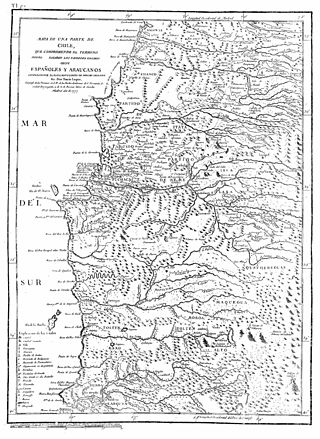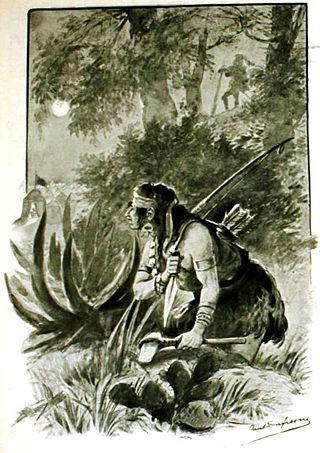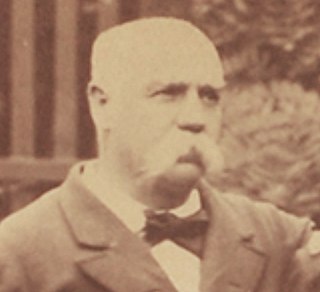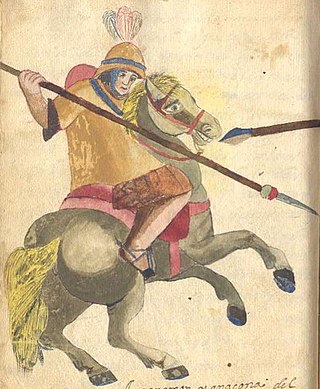
The Arauco War was a long-running conflict between colonial Spaniards and the Mapuche people, mostly fought in the Araucanía region of Chile. The conflict began at first as a reaction to the Spanish conquerors attempting to establish cities and force Mapuches into servitude. It subsequently evolved over time into phases comprising drawn-out sieges, slave-hunting expeditions, pillaging raids, punitive expeditions, and renewed Spanish attempts to secure lost territories. Abduction of women and war rape was common on both sides.

Toqui is a title conferred by the Mapuche on those chosen as leaders during times of war. The toqui is chosen in an assembly or parliament (coyag) of the chieftains (loncos) of various clans (Rehues) or confederation of clans (Aillarehues), allied during the war at hand. The toqui commanded strict obedience of all the warriors and their loncos during the war, would organize them into units and appoint leaders over them. This command would continue until the toqui was killed, abdicated (Cayancaru), was deposed in another parliament, or upon completion of the war for which he was chosen.
Boroa, is a town in Araucanía, Chile on the shores of Cautín River. The region near the town south of the Cautin River between the Boroa and Quepe Rivers was the Moluche aillarehue of Boroa. The site of the town was founded as a Spanish fort San Ignacio de la Redención in 1606 by maestre de campo Rodulfo Lisperger during the Arauco War but it did not remain long after he and his garrison were ambushed. Later in 1649 as a result of the Parliament of Quillín (1647), Martín de Mujica y Buitrón was able to reestablish the fort at Boroa but it was abandoned in 1656 after a long siege during the Mapuche uprising of 1655. One could still find vestiges of the old Spanish fort near the mission at its location at the end of the 19th century.
The Battle of Mataquito was fought in the Arauco War on April 30, 1557, between the forces of the Spanish governor, Francisco de Villagra, and Mapuche headed by their toqui Lautaro. It was a surprise attack, carried out at dawn, on Lautaro's fortified camp between a wooded mountain and the shore of the Mataquito River. The battle is notable for ending Mapuche designs on Santiago, while also avenging the death of former governor Pedro de Valdivia, who had been killed by Lautaro's warriors four years earlier.
The Battle of Millarapue that occurred November 30, 1557 was intended by the Toqui Caupolicán as a Mapuche ambush of the Spanish army of García Hurtado de Mendoza that resulted in a Spanish victory when the ambush failed.
Caupolicán the Younger according to Juan Ignacio Molina was the son of the toqui Caupolicán. He was made toqui following the capture and execution of his father in 1558. He continued the first Mapuche rising against the Spanish conquistadors in 1558 and commanded the Mapuche army in constructing a pukara at Quiapo to block García Hurtado de Mendoza from rebuilding a fort in Arauco completing the chain of forts for suppression of their rebellion. In the Battle of Quiapo the Mapuche suffered a terrible defeat and there Caupolicán the younger died. His successor as toqui was Illangulién.
Cadeguala or Cadiguala was a Mapuche toqui elected in 1585 following the death in battle of the previous toqui Nangoniel. Cadeguala was a noted warrior and the first Mapuche toqui known to have used cavalry successfully in battle. He was killed in a duel with the garrison commander of the Spanish fort at Purén in 1586.
Paineñamcu or Paynenancu or Alonso Diaz, was the Mapuche toqui from 1574 to 1584. Alonso Diaz was a mestizo Spanish soldier offended because the Governor of Chile did not promote him to the officer rank of alféres, who subsequently went over to the Mapuche in 1572. He took the Mapuche name of Paineñamcu and because of his military skills was elected toqui in 1574 following the death of Paillataru.

Battle of Quiapo in the Arauco War was the final battle in the campaign of García Hurtado de Mendoza against the Mapuche under the toqui known as Lemucaguin or Caupolicán the younger. It was fought in Quiapo, in the region nowadays known as Arauco Province, Chile on December 13, 1558. The importance of this battle was the first time that the Mapuche fought using a squad that carried firearms.
Cayancura, or Cayeucura, was a Mapuche leader native to the region of Marigüenu, chosen as toqui in 1584 to replace the captured Paineñamcu. His one great operation was an attempted siege of the fort at Arauco that failed, leading to his abdication of his office in favor of his son Nangoniel in 1585.

Lientur was the Mapuche toqui from 1618 to 1625. He was the successor to Loncothegua. Lientur with his vice toqui Levipillan was famed for his rapid malóns or raids. Because of his ability to slip back and forth over the Spanish border between its fortresses and patrols and raid deep into Spanish territory north of the Bio-Bio River without losses he was called the Wizard by the Spanish.
Millalelmo or Millarelmo was a Mapuche military leader in the second great Mapuche rebellion that began in 1561 during the Arauco War. Probably the toqui of the Arauco region, he commanded the Mapuche army of that area at the siege of Arauco from May 20 to June 30, 1562.
Pedro de Avendaño a Spanish soldier that had arrived in Chile with the army of García Hurtado de Mendoza in 1557. He distinguished himself in the Battle of Millarapue. He later served in the garrison of Cañete under captain Alonso de Reinoso. Reinoso eventually found an Indian who betrayed the location of the fugitive Mapuche toqui Caupolicán. Avendaño, with 50 men and the traitorous Indian as a guide, marched in stormy weather into the mountains to Pilmaiquén and captured Caupolicán as he was planning a new counter-offensive against the Spanish, near the modern Antihuala, on February 5, 1558. He brought the toqui back to Cañete where he was eventually executed by impalement at the order of corregidor Reinoso.
Turcupichun was the toqui of the Mapuche Aillarehues in the vicinity of Concepcion, Chile and the Bio-Bio River valley from 1557 to 1558. García Hurtado de Mendoza landed in early June 1557 on the island of La Quiriquina at the mouth of the bay of San Pedro. Soon afterward he sent out messengers to the local Aillarehues to come and submit to the Spanish. Turcupichun gathered them in a great coyag where he advocated resistance to the death and elected him as their toqui replacing the dead Lautaro.
Lemucaguin a native of Andalicán was the successor to Turcupichun as toqui of the Moluche Butalmapu north of the Biobío River in 1558. He organized a detachment of arquebusiers from weapons captured in the Battle of Marihueñu. He continued the war against García Hurtado de Mendoza after the executions of Caupolican and Turcupichun. Establishing pucaras at Quiapo and other locations to block Spanish access to the Arauco region. He was the first toqui to use firearms and artillery in the Battle of Quiapo However he was killed in this battle and was replaced by Illangulién. The later historian, Juan Ignacio Molina, calls the toqui that led at Quiapo Caupolicán the younger, son the executed toqui Caupolican
Butapichón or Butapichún or Putapichon was the Mapuche toqui from 1625 to 1631, as successor to Lientur. After the death of Quepuantú in 1632 he became toqui once again from 1632 to 1634.

Benjamín Vicuña Mackenna was a Chilean writer, journalist, historian and politician. Vicuña Mackenna was of Irish and Basque descent.

Anganamón, also known as Ancanamon or Ancanamun, was a prominent war leader of the Mapuche during the late sixteenth and early seventeenth centuries and a Toqui from. Anganamón was known for his tactical innovation of mounting his infantry to keep up with his cavalry.

Carelmapu is a port and town at the western end of Chacao Channel, southern Chile. Carelmapu was established by the Spanish in 1602 as San Antonio Ribera de Carelmapu following the Destruction of Seven Cities. In 1643 Carelmapu was sacked and its church vandalized by the Dutch corsair Hendrick Brouwer. On March 6, 1676 Carelmapu received the exhausted survivors of Pascual de Iriarte's expedition to the Strait of Magellan.
Juan Moscoso was a Chilean criollo Jesuit. He was fluent in Spanish and Mapudungun. Together with fellow Jesuit Diego de Rosales Moscoso dissuaded governor Governor of Chile Antonio de Acuña Cabrera to launch new punitive expeditions against the Cunco in 1653. They argued that the murders were committed by a few Indians and warned the governor that renewing warfare would evaporate gains obtained at Boroa.







